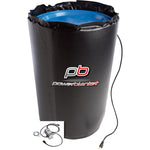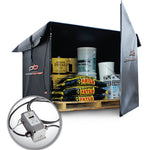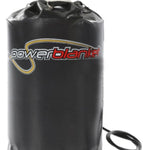You have no items in your shopping cart.
Article At-a-Glance
At What Temperature Do Pipes Freeze?
Pipes can freeze when temperatures drop to 20°F or lower, but factors like insulation, pipe type, and location can influence this threshold, making it crucial to take preventative measures such as using heat trace, pipe heaters, and proper insulation to protect your pipes.
Key Takeaways
- Understand the Risk: Pipes typically freeze at 20°F or lower, but factors like insulation, pipe type, and location can alter this threshold.
- Key Influences: Insufficient insulation, prolonged exposure to cold, and unheated areas increase the risk of pipes freezing.
- Prevention Strategies: Use heat trace cables, pipe heaters, and proper insulation to protect pipes from freezing.
- Immediate Actions: If pipes freeze, turn off the water supply and use safe methods like space heaters or hair dryers to thaw them.
- Proactive Measures: Keep water flowing and allow warm air to circulate around pipes to prevent freezing and potential bursts.
Reasons Why Pipes Freeze and How to Prevent Freezing
As the cold weather sets in, many homeowners face the possibility of frozen pipes. When water freezes inside pipes, it expands and can cause the pipes to burst, leading to costly damages and inconvenience. So, at what temperature do pipes freeze in a house? Pipes can freeze when the temperature drops to 20°F or lower. However, this can vary depending on factors such as insulation, the type of pipes, and the location of the pipes.
Frozen pipes can cause significant damage to homes and properties, leading to expensive repairs and disruptions to daily life. The best way to prevent frozen pipes is to ensure that water pipes are properly insulated. This is especially important for pipes located in unheated areas, such as attics, crawl spaces, and basements.

Preventing frozen pipes is crucial, and there are several ways to do so. In this article, we will explore three ways to prevent frozen pipes this winter: using heat trace, pipe heaters, and insulation.
Heat Trace:
Heat trace is an electrically heated cable designed to wrap around pipes and keep them warm. Heat trace prevents pipes from freezing by maintaining a constant temperature, even in cold temperatures. Heat trace is especially useful for exposed pipes, which are more vulnerable to freezing.
Installing heat traces on your pipes is a straightforward process. First, you'll need to measure the length of the pipe you want to cover with the heat trace. Next, you'll need to choose the appropriate heat trace cable for your pipes. Finally, you'll need to wrap the cable around the pipe, making sure to overlap it slightly and secure it with tape.

$780.00 USD
4" to 5" Diameter x 5' Long Xtreme Pipe Wrap Heater (120V)
Pipe Heaters:
Pipe heaters, also known as pipe insulation heaters, are another way to prevent frozen pipes. These heaters work by warming the water inside the pipes, preventing them from freezing. There are different types of pipe heaters available, including self-regulating heaters and constant-wattage heaters.
Self-regulating heaters are designed to automatically adjust their heat output based on the temperature of the pipe. Constant wattage heaters, on the other hand, provide a constant amount of heat. Both types of pipe heaters are effective in preventing frozen pipes.
To install pipe heaters, you'll need to measure the length of the pipe you want to cover, choose the appropriate heater, and wrap it around the pipe. You can secure the heater in place with tape or zip ties.
Insulation:
Insulating your pipes is an effective way to prevent frozen pipes. Insulation helps to keep the water in the pipes warm, preventing it from freezing. There are several types of insulation materials available, including fiberglass, foam, and rubber.
To insulate your pipes, you'll need to first identify which pipes are at risk of freezing. Next, you'll need to choose the appropriate insulation material for your pipes. Finally, you'll need to wrap the insulation around the pipes, making sure to cover them completely.

It's essential to note that insulation is most effective when used on indoor pipes. Outdoor pipes may require additional measures, such as heat trace or pipe heaters.
What to Do If Your Pipes Freeze
Even with preventative measures in place, pipes can still freeze. If you suspect that your pipes have frozen, there are several steps you can take to thaw them and prevent them from bursting.
First, turn off the water supply to the affected pipes. This will prevent water from flowing into the pipes and causing further damage. To thaw a frozen pipe, you can use a space heater, hair dryer, or heat lamp. Never use an open flame or blowtorch, as this can be extremely dangerous and can cause fires. You can also try wrapping the frozen pipe in towels soaked in hot water or pouring boiling water over the pipe. However, it's important to use caution and avoid overheating the pipe, as this can also cause damage. Never use a blowtorch or other open flame to thaw frozen pipes, as this can be extremely dangerous.
Preventing Burst Pipes
If a pipe bursts, it can cause extensive damage to your home. To prevent burst pipes, it's important to take preventative measures before the cold weather sets in.
One way to prevent burst pipes is to keep the water flowing. Even a small amount of water running through the pipes can help prevent them from freezing. You can also open cabinet doors under sinks to allow warm air to circulate around the pipes and prevent freezing.
Stay Ahead of the Freeze: Preventing Burst Pipes in Cold Weather
In conclusion, frozen pipes can be a major headache for homeowners, but there are many ways to prevent them from happening in the first place. Proper insulation, regular maintenance, and quick action when pipes freeze can help keep water flowing and homes safe during the coldest months of the year.
In this article, we've explored three effective ways to prevent frozen pipes: using heat trace, pipe heaters, and insulation. By following these preventative measures, you can avoid the expense and inconvenience of dealing with frozen and burst pipes. Heat Authority has a variety of solutions, ready-to-ship, and custom, to help prevent a broken pipe and freezing temperatures for getting in the way of your water flow.
Remember, if you suspect that your pipes have frozen, it's important to take immediate action to prevent the pipe from bursting. By turning off the water supply to the affected area and taking steps to thaw the frozen pipes, you can prevent costly damage to your home.
By taking preventative measures and staying vigilant, you can ensure that your pipes stay in good condition, and your home stays safe and warm during the cold winter months.













